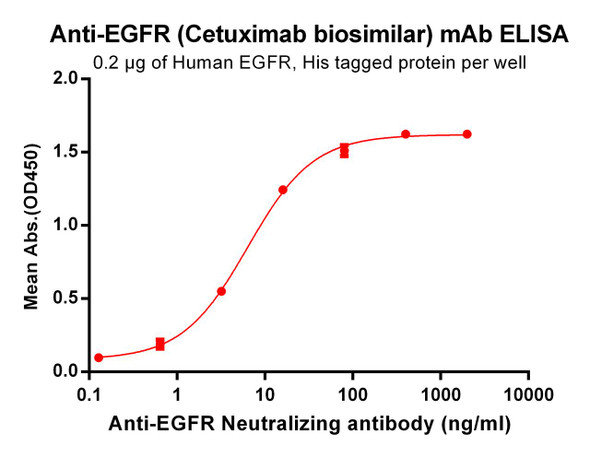VivoGenie Anti-EGFR (Cetuximab) Biosimilar (IVMB0238)
- SKU:
- IVMB0238
- Antibody Type:
- In Vivo Biosimilar
- Endotoxin Level:
- Low Endotoxin
- Applications:
- In Vivo
- Disease Area:
- Lung Cancer
- Disease Area:
- Colorectal Cancer
- Protein:
- EGFR
- Clone:
- C225
- Isotype:
- IgG1 kappa
- Reactivity:
- Human
- Synonyms:
- ErbB-1, HER1, epidermal growth factor receptor
Description
system_update_altDatasheet
| Product Name: | Cetuximab (Anti-EGFR) Biosimilar In Vivo Antibody |
| Product Code: | IVMB0238 |
| Clone: | C225 |
| Protein: | EGFR |
| Product Type: | Biosimilar Recombinant Human Monoclonal Antibody |
| Synonyms: | ErbB-1, HER1, epidermal growth factor receptor |
| Isotype: | Human IgG1κ |
| Reactivity: | Human |
| Immunogen: | Human EGFR/ErbB1 |
| Applications: | B, CyTOF®, ELISA, FC, ICC, IHC |
| Formulation: | This biosimilar antibody is aseptically packaged and formulated in 0.01 M phosphate buffered saline (150 mM NaCl) PBS pH 7.2 - 7.4 with no carrier protein, potassium, calcium or preservatives added. Due to inherent biochemical properties of antibodies, certain products may be prone to precipitation over time. Precipitation may be removed by aseptic centrifugation and/or filtration. |
| Endotoxin Level: | < 1.0 EU/mg as determined by the LAL method |
| Purity: | ≥95% monomer by analytical SEC |
| Preparation: | Functional grade preclinical antibodies are manufactured in an animal free facility using only In vitro protein free cell culture techniques and are purified by a multi-step process including the use of protein A or G to assure extremely low levels of endotoxins, leachable protein A or aggregates. |
| Storage and Handling: | Functional grade biosimilar antibodies may be stored sterile as received at 2-8°C for up to one month. For longer term storage, aseptically aliquot in working volumes without diluting and store at -80°C. Avoid Repeated Freeze Thaw Cycles. |
| Applications: | B, CyTOF®, ELISA, FC, ICC, IHC |
| Recommended Usage: | FC The suggested concentration for Cetuximab biosimilar antibody for staining cells in flow cytometry is ≤ 0.25 µg per 106 in a volume of 100 µl. Titration of the reagent is recommended for optimal performance for each application. |
| Reactivity: | Human |
| Specificity: | This non-therapeutic biosimilar antibody uses the same variable region sequence as the therapeutic antibody Cetuximab. Clone C225 recognizes human EGFR. This product is for research use only. |
| Antigen Distribution: | EGFR is ubiquitously expressed and found in the plasma membrane. |
| Immunogen: | Human EGFR/ErbB1 |
| Concentration: | ≥ 5.0 mg/ml |
| Endotoxin Level: | < 1.0 EU/mg as determined by the LAL method |
| Purity: | ≥95% monomer by analytical SEC |
| Formulation: | This biosimilar antibody is aseptically packaged and formulated in 0.01 M phosphate buffered saline (150 mM NaCl) PBS pH 7.2 - 7.4 with no carrier protein, potassium, calcium or preservatives added. Due to inherent biochemical properties of antibodies, certain products may be prone to precipitation over time. Precipitation may be removed by aseptic centrifugation and/or filtration. |
| Preparation: | Functional grade preclinical antibodies are manufactured in an animal free facility using only In vitro protein free cell culture techniques and are purified by a multi-step process including the use of protein A or G to assure extremely low levels of endotoxins, leachable protein A or aggregates. |
| Storage and Handling: | Functional grade biosimilar antibodies may be stored sterile as received at 2-8°C for up to one month. For longer term storage, aseptically aliquot in working volumes without diluting and store at -80°C. Avoid Repeated Freeze Thaw Cycles. |
EGFR is a 170 kD transmembrane glycoprotein that is part of the ErbB family of receptors within the protein kinase superfamily. EGFR is one of four closely related receptor tyrosine kinases: EGFR (ErbB-1), HER2/c-neu (ErbB-2), Her 3 (ErbB-3) and Her 4 (ErbB-4). EGFR is essential for various processes including controlling cell growth and differentiation and ductal development of the mammary glands. Ligand binding induces dimerization and autophosphorylation. It consists of a glycosylated extracellular domain which binds to EGF and an intracellular domain with tyrosine-kinase activity necessary for signal transduction. TGFα, vaccinia virus growth factor, and related growth factors can also bind to and signal through EGFR. Abnormal EGFR signaling has been implicated in inflammatory diseases such as psoriasis, eczema and atherosclerosis. Alzheimer's disease is linked with poor signaling of the EGFR and other receptor tyrosine kinases. Furthermore, over-expression of the EGFR is linked with the growth of various tumors. EGFR has been identified as an oncogene, a gene which in certain circumstances can transform a cell into a tumor cell, which has led to the therapeutic development of anticancer EGFR inhibitors. EGFR is a well-established target for both mAbs and specific tyrosine kinase inhibitors. Anti-Human EGFR (Cetuximab) utilizes the same variable regions from the therapeutic antibody Cetuximab making it ideal for research projects.
| Protein: | EGFR |






